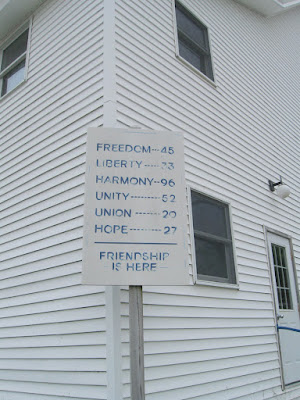 |
| My runs on Bradford (top), Davis and Martin points |
I spent last week in this little lobstering village in Midcoast Maine. Friendship is spread out along four points along the coast: Bradford, Davis, Martin, and Wadsworth. I managed to run the first three of three of them (right) this year. Last summer, when I was in better shape, I did three points in one run. I had vowed to do all four this year, a run of roughly 18 or 19 miles. Nope.
Friendship's main claim to fame is the Friendship sloop, a small sail boat that was favored by New England's commercial fishers. The town has long had a sizable summer community—John Cheever vacationed here—and second homes dominate the coastline, but it still has a busy working waterfront. By all accounts, the lobstermen of Friendship have been having a tough time lately: Notice all the hot new lobster-roll restaurants in New York? They're a pretty much direct result of a crash in Maine lobster prices.
Lobstering is a territorial business. As Colin Woodard explains in his terrific book The Lobster Coast, local lobster gangs—that's what they're called— have a lot of, shall we say, informal ways of defending their traditional bit of the water. Occasionally this has escalated in to “lobster wars.” In 1995, Friendship tried to push into the waters claimed by Monhegan Island’s lobster fleet. “Traps were cut,” writes Woodard, “and, near the end of the season, vandals sank John Murdock's Sea Hag while she sat at her mooring in Port Clyde, causing $13,000 in damage.” Fishermen were carrying guns. Since then, Maine has allowed lobsterman to participate in the official regulation of the sea bottom. But Woodard argues that the old system of traditional fishing grounds helped to defeat the tragedy of the commons and keep lobstering sustainable, even as the Gulf of Maine cod fishery collapsed.
I really can't recommend The Lobster Coast strongly enough, especially if you spend any time in coastal Maine—but also if you live in or love any place that's grappled with growth and economic dislocation (Brooklyn... Montana...) It's a popular history written by a journalist, but unlike most books of that type, it's really smart about social history and economics. Woodard shows how Maine's economy has shaped its landscape, and vice-versa. Here he makes the intriguing argument that coastal Maine, which all us folks from "away" love so much because it seems timeless and unspoiled, was really America's first Detroit:
Maine wasn't preindustrial; it had just been deindustrialized.
...Maine ice, granite, lumber, salt cod, and foodstuffs filled the docks of the United States' Atlantic ports, themselves clogged with Maine-built sailing ships. But those goods had been displaced by refrigerators and cement, by fresh fish caught by Gloucester steamships and cheap lumber and foodstuffs moved from the Midwest by the nation's railroads. Practically overnight, all of Maine's industries collapsed. As a result, the coast was losing population. The wild meadows and weather-beaten farmhouses the summer people found so picturesque had been abandoned by their owners, thousands of whom had moved to Ohio in hopes of a better life. With the offshore fishing industry in decline, residents of many coastal towns tried to build an industry around the only resource they had left: the summer people themselves.Woodard spends a lot of time of the delicate relationship between outsiders and locals. The vacationers aren't new interlopers: They've been a big part of the economy in Maine for over a century. But the flood of new development since the 1990s has made it harder to keep the working waterfronts open, and for the people who work on the water to live anywhere near it. The Island Institute does work on these issues, including publishing this excellent newspaper I've subscribed to for the past couple of years. Good local journalism is itself activism.
On to the pictures, most of them after the jump.
Run to Davis Point
 |
| From mainephotojog Friendship's famous sign, at the Mason Lodge |



